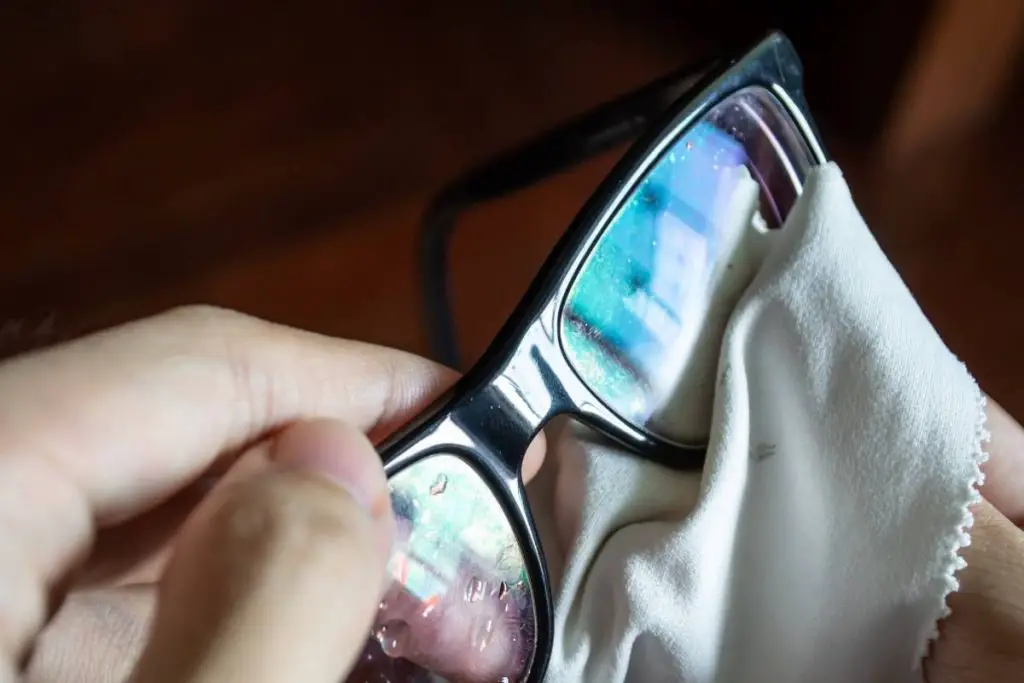Cleaning glass is always a challenge — whether it’s wine glasses, windows, or your reading spectacles, you want to avoid smudges or streaks. But you don’t want to use anything too harsh; otherwise, you’ll leave scratches, which is even worse. Can you use a microfiber cloth, and will it scratch glass?
A microfiber cloth won’t scratch glass. Microfiber is soft but very tough, making it ideal for cleaning, buffing, or drying all sorts of delicate materials. As long as the cloth itself is clean, you shouldn’t have to worry about scratching.
Read on as I talk more about microfiber, what it is, and why it’s so useful for cleaning glass. I’ll also give you a few tips for cleaning many of the different glass objects you have around the home.

What Is Microfiber?
Microfiber is the technical name for cloth made up of threads with a diameter of less than 10 micrometers (0.00039 in), which is one-millionth of a meter. To put it another way, individual threads should be 1/100 of a millimeter. By comparison, an average human hair would be about ten times as wide.
A microfiber is roughly as wide as a typical strand of silk, but microfibers are artificial, similar to polyester or nylon. This gives microfiber cloth a smoothness comparable to silk, but makes microfiber cloth much less expensive.
Microfiber’s density also makes it very strong and durable. At the same time the tightly-knit fibers resist stains while they wick away moisture. Microfibers can also stretch while retaining their shape, and they can be made so that they’re soft and comfortable.
Microfiber cloth is used for a wide range of garments, from athletic apparel to undergarments. But they are also helpful for cleaning and buffing.
Source: Wikipedia
Why Use Microfiber To Clean Glass
Because it’s so dense, microfibers are great for cleaning off smudges and fingerprints. Their slight static charge is also helpful for picking up lint. If you want something to really shine, wiping with a microfiber cloth will really help.
The same goes for glass: if you need it to be absolutely sparkling clear — for practical or aesthetic reasons — microfiber is the best choice for cleaning and buffing.
With glass, you also want a material that won’t scratch the surface. That means you want a material with a combination of durability and softness: durability, so it’ll work to pick up dirt and oil and softness to protect the delicate surface.
A clean microfiber cloth will have the ideal combination, so you get clean, clear glass with no risk of scratches.
Is Microfiber Good for Cleaning Mirrors?
Microfiber is good for cleaning all kinds of glass surfaces, including mirrors. The tiny fibers are great for removing smudges and dust without leaving streaks or scratches. If you want them to look their best, use a microfiber cloth for cleaning off your mirrors.
Your bathroom mirror can pick up all sorts of residue: steam from the shower, hairspray, even bits of toothpaste if someone in your household is a vigorous tooth-brusher. So you may want to set aside the regular window cleaner and use diluted ammonia or vinegar instead. But whatever chemical you use, microfiber cloth is best for drying and buffing your mirror.
Cleaning Different Glass Objects Using Microfiber Cloth
Glass comes in many shapes and sizes. Here are some tips on cleaning all the different types of glass you may have around your home:
Windows
You don’t need a whole lot of soap to clean window glass, and too much soap will add deposits that result in streaks, so go easy on the soapy water or window cleaner.
Many people will dilute window cleaner with clean water, but be careful: “hard” water with high amounts of impurities will leave calcium deposits too, defeating the whole purpose. If you don’t trust the water from your tap, you can buy distilled water and use that instead.
If you’re out of window cleaner, you can dilute ammonia with clean water. Or if you want to go green and use natural ingredients, try washing your windows with diluted vinegar.
Whatever liquid you choose, don’t use paper towels for drying; they tend to leave lint. You’re honestly better off using newspapers rather than paper towels. But microfiber cloth is your best choice for cleaning and buffing.
Wine Glasses
If you want to impress your friends at your next dinner or party, having crystal-clear, smudge-free glassware definitely helps. Wine glasses in particular can be tricky, but microfiber cloth makes it a lot easier.
First, make sure you use unscented dish soap. Scented soap can leave a residue that’ll alter the taste of wine (or any other beverage) when you drink it.
For everyday use, you should be fine letting your glasses drip dry, but if you want to impress company, hand drying your glasses will make them really sparkle. For delicate glassware, especially wine glasses, you should hold the glass by the bowl instead of the stem. That’ll reduce the risk that you’ll accidentally break the stem off.
Eyewear
Whether you have regular eyeglasses, a pair of “cheaters” for reading or a pair of sunglasses for when you go outside, a smudge or a scratch on one of your lenses can be a real distraction. So it’s very important to keep your glasses clean and do it the right way.
Using your shirt or a piece of facial tissue in a pinch is perfectly understandable; just about everyone has done it. But cleaning your glasses right takes a little clean water and a microfiber cloth.
For really stubborn smudges, run your glasses under a bit of tap water and add some lotion-free dish liquid. Rub the glasses gently with a microfiber cloth, then rinse. After that, use another piece of microfiber cloth to dry your glasses off.
How To Clean Microfiber Cloth
Microfiber itself won’t scratch glass, but tiny particles of dirt or grit can get lodged in the fabric over time, and those can cause scratches.
Fortunately, microfiber is easy to clean: you can run them through your washing machine. Use a gentle, bleach-free detergent, and run on the delicate cycle. Additionally, avoid using powdered laundry detergent — these can leave undissolved grains of detergent in your clothes, which can act like grit and leave scratches!
After that, you can run them through the dryer on low heat. Don’t use a dryer sheet or dry microfiber with cotton clothes — your microfiber may pick up lint. You probably won’t need to leave them in the dryer very long; microfiber dries out pretty quickly.
Conclusion
Microfiber cloths are great for cleaning and polishing just about anything made of glass. Just be sure to clean your clothes periodically so they don’t pick up dirt and grit. You’ll get clean, clear glass without having to worry about scratches.
Recommended Reading:
Declutter your home once and for all (Even if you have no time and don't know where to begin)! Learn More.



